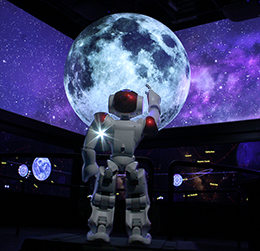05 April 2018
 Australia’s first Science on a Sphere installed at UniSA
Australia’s first Science on a Sphere installed at UniSA
Unravelling the mysteries of our solar system will be at the tips of your fingers when Australia’s first Science On a Sphere® (SOS) lands at the University of South Australia’s futuristic museum of discovery - MOD., set to open on May 11.
The 1.8 metre diameter globe will be a permanent fixture at MOD. but SOS has the unique capacity to transform itself – one day it’s the earth, the next, the moon or even a Mars landscape.
From the shock waves of a tsunami, the craters of Callisto, or the impact of an ice age, SOS can reveal novel perspectives about global, planetary and interplanetary conditions.
A spherical projection system, SOS uses computers and video projectors to illuminate the suspended globe, enabling animated visualisations of natural sciences, global events or cosmic phenomenon, using current, historical, or theoretical data.
Director of MOD. Dr Kristin Alford, says that the arrival of SOS, presents an exciting opportunity for South Australians to experience a sophisticated education resource never before accessible in Australia.
“The Science on a sphere is a powerful data visualisation tool that illustrates the complexities of our planet to people of all ages,” Dr Alford says
“Through illuminated and dynamic images on the sphere, visitors can see atmospheric storms, changes in sea levels and ocean temperatures, the migration paths of sea turtles, as well as light pollution, global navigation paths or marine migration all in real time.
A feature of MOD.’s Universal Gallery, SOS is part of the ‘Our Sky’ exhibit which invites visitors to find their own path through the universe and discover Aboriginal and Western perceptions of astronomy through an immersive and interactive experience with visitors able to transform the sphere into any planet in our solar system.
Created by the National Oceanic and Atmospheric Administration (NOAA) in the United States, SOS is an interactive display, enabling interaction with over 500 data sets and cloud services, each customised for SOS’s spherical projection surface.
“Normally, images are projected onto a flat screen, like movies in a cinema. But in the case of SOS, the images need to be precisely distorted, making them appear normal when they’re projected onto the sphere,” Dr Alford says.
“Engaging with SOS is so much more immersive and enriching than watching an ordinary screen,” Dr Alford says.
“And when the storms of Saturn, or the movements of the Earth’s tectonic plates are within arm’s reach it really is something to watch.”
Located within UniSA’s new Cancer Research Institute on North Terrace, MOD. is open Tues-Thurs 12-6pm, Fri 12-8pm and Sat-Sun 10-4pm. It is accessible to all members of the public, yet is recommended for ages 15 and above.
Media contact: Michele Nardelli mobile: +61 418 823 673 email: Michele.Nardelli@unisa.edu.au
Notes to editor:
- MOD. – UniSA’s futuristic museum of discovery opens to the public on Friday 11 May and includes seven gallery spaces over two levels
- The data visualisations presented on the Science on a Sphere will change for each exhibition
- The Universal Gallery also includes three walls of touch-screens, featuring the Microsoft World Wide Telescope developed by Microsoft’s Curtis Wong, a recent Honorary Doctorate of UniSA


